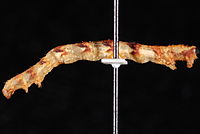Eupithecia scabrogata
Jump to navigation
Jump to search
| Eupithecia scabrogata | |
|---|---|

| |
| Scientific classification | |
| Kingdom: | Animalia |
| Phylum: | Arthropoda |
| Class: | Insecta |
| Order: | Lepidoptera |
| Family: | Geometridae |
| Genus: | Eupithecia |
| Species: | E. scabrogata
|
| Binomial name | |
| Eupithecia scabrogata | |
| Synonyms | |
| |
Eupithecia scabrogata is a moth in the family Geometridae first described by Pearsall in 1912. It is found in western North America from British Columbia to California and Arizona.
The wingspan is about 19 mm. The forewings are smoky brown with obscure crosslines.[3] Adults have been recorded on wing from November to March and in May, possibly representing a second generation.
The larvae feed on the flowers of Arbutus pungens.[4] They are cryptically patterned and colored to match the flowers of their host plant.
References
- ^ Yu, Dicky Sick Ki. "Eupithecia scabrogata Pearsall 1912". Home of Ichneumonoidea. Taxapad. Archived from the original on March 24, 2016.
- ^ "910422.00 – 7583 – Eupithecia scabrogata – Pearsall, 1912". North American Moth Photographers Group. Mississippi State University. Retrieved May 1, 2019.
- ^ McDunnough, James H. (1949). "Revision of the North American species of the genus Eupithecia (Lepidoptera, Geometridae)" (PDF). Bulletin of the American Museum of Natural History. 93: 533–728.
- ^ Ferris, Clifford D. (2004). "Taxonomic note on four poorly known Arizona Eupithecia Curtis (Lepidoptera: Geometridae: Eupitheciini)" (PDF). Zootaxa. 738: 1–19. doi:10.5281/zenodo.158660.
Wikimedia Commons has media related to Eupithecia scabrogata.
Wikispecies has information related to Eupithecia scabrogata.
Error: "Q13553288" is not a valid Wikidata entity ID.
Categories:
- Articles with short description
- Short description with empty Wikidata description
- Articles with 'species' microformats
- Commons link is the pagename
- Taxonbars desynced from Wikidata
- Taxonbar pages requiring a Wikidata item
- Taxonbars with invalid from parameters
- Taxonbars without secondary Wikidata taxon IDs
- Moths described in 1912
- Eupithecia
- Moths of North America
- All stub articles
- Eupithecia stubs
